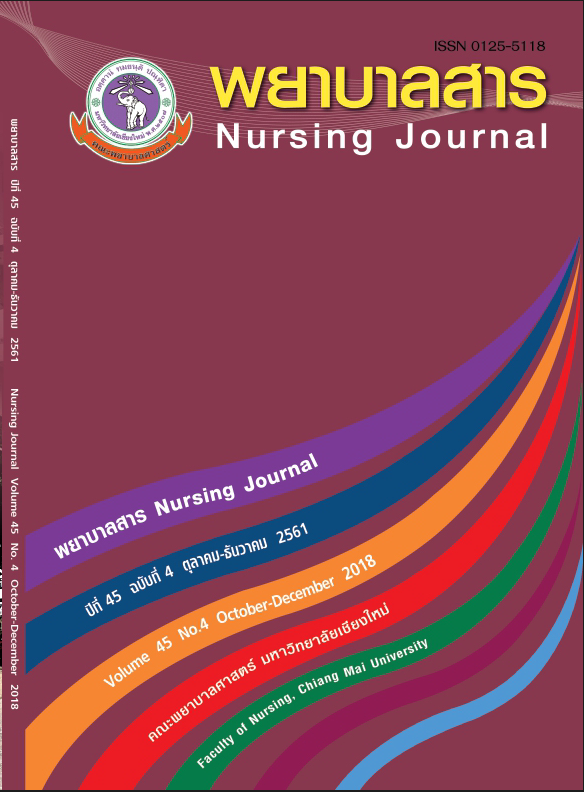Surveillance Practices and Related Factors of Surgical Site Infection in Government Hospitals
Keywords:
Practices, Surveillance, Surgical Site Infection, Related Factors, government hospitalsAbstract
The surveillance of surgical site infections (SSI) can help surgical facilities determine the situation and trend of SSI leading to effective SSI prevention and reducing the incidence of SSIs. This descriptive study aimed to study the SSI surveillance practices and related factors at government hospitals from June 2014 to March 2015. The samples consisted of 99 infection control nurses or key responsible persons for SSI surveillance in government hospitals. (80.49%) The research instrument was a questionnaire consisting of 4 parts: a demographic questionnaire, a hospital information questionnaire, a surveillance practices questionnaire, and a SSI surveillance related factors questionnaire. Data were analyzed using descriptive statistics
The study found that most SSI data collection and recording was performed by infection control ward nurses (72.73%). The US Centers for Disease Control and Prevention definition was used to classify SSIs (68.69 %). Most SSIs were diagnosed by surgeons (61.62%). The SSI rates were analyzed monthly (73.74%) and data were electronically recorded (51.52%). Post-discharge surveillance was performed (83.84%) SSI surveillance efficiency were evaluated (24.24%). The factors related to the SSI surveillance practices were: 1) the structure: the hospital had full-time infection control nurses (71.72%); 2) the process: the hospital organized training on SSI prevention for new personnel (73.74%) and conducted refresh training for involved personnel (84.85%); and 3) the outcome: most respondents agreed that changing the responsible person for SSI surveillance affected the SSI surveillance system (61.62%) and that they required support from colleagues (88.89%).
The findings showed that there were a variety of SSI surveillance practices in government hospitals. Planning and developing SSI surveillance procedures are recommended to improve SSI surveillance of Thai government hospitals of standard comprehension
References
From http://www.cdc.gov/nhsn/pdfs/pscmanual/ 9pscssicurrent.pdf.
Chang, W. K., Srinivasa, S., MacCormick, A. D., & Hill, A. G. (2013). Gentamicin-Collagen Implants to reduce surgical site infection systematic review and meta-analysis of randomized trials. Annals of Surgery, 258(1), 59-65.
Danchaivijitr, S., Judaeng, T., Sripalakij, S., Naksawas, K., & Plipat, T. (2007). Prevalence of Nosocomial Infection in Thailand 2006. Journal Medicine Associated Thailand, 90(8), 1524-1529.
Kasatpibal, N., Thongpiyapoom, S., Narong, M., Suwalak, N., & Jamulitrat, S. (2005). Extra charge and extra length of postoperative stay attributable to surgical site infection in six selected operations. Journal of Medical Association of Thailand, 88(8), 1083-1090.
Kasatpibal, N. (2006). The development of surgical site nosocomial infection surveillance network in southern Thailand. Research Report: Health Systems Research Institute (HSRI). (In Thai)
Kasatpibal, N. (2010). Strategies for Improvement of Infection Prevention and Control. Chiang Mai: Mingmuang. (In Thai)
Krejcie, R. V., & Morgan, D. W. (1970). Determining sample size for research activities. Educational and Psychological Measurement, 30(3), 607-610.
Lamkar, U., Kasatpibal, N., & Chitreecheur, J. (2012). Effect of prevention of infection reinforcement among healthcare personnel on incidence of surgical site infection in caesarean section. Nursing Journal, 39(4), 85-96. (In Thai)
Leaper, D., Tanner, J., & Kiernan, M. (2013). Surveillance of surgical site infection: more accurate
definitions and intensive recording needed. Journal of Hospital Infection, 83, 83-86.
Niyomwit, K., & Prachusilpa, G. (2015). Competency of infectious control ward nurse. Journal of The Police Nurse, 7(1), 153-165. (In Thai)
Saranya Nimitkul. (2000). Effects of quality control circle on efficiency of nosocomial infection surveillance by infection control ward nurse in Trang Hospital. (Master’s thesis of Infection Control Nursing). Graduate School, Chiang Mai University. (In Thai)
Serra-Aracil, X., Garcia-Domingo, M. I., Pares, D., EspinBasany, E., Biondo, S., Guirao, X.,...Sitgr-Serra, A. (2011). Surgical site infection in elective operations for colorectal cancer after the application of preventive measures. Archives of surgery, 146(5), 606-612.
Thongcharoen, P., Moongtui, W., & Unahalekhaka, A. (2015). Effects of using multifaceted strategic method on practices of healthcare personnel in prevention of multidrug resistant bacterial infection. Nursing Journal, 42(1), 61-73. (In Thai)
Tanner, J., Padley, W., Kiernan, M., Leaper, D., Norrie, P., & Baggott, R. (2013). A benchmark too far: Findings from a national survey of surgical site infection surveillance. Journal of Hospital Infection, 83, 87 -91.
World Health Organization. (2009). Safe surgery saves lives WHO guidelines for safe surgery. Retrieved 4 February 2015 From http://www.whqlibdoc.who.int/publications/2009 /978924159 855 23_ eng.pdf.
Zarb, P., Coignard, B., Griskeviciene, J, Muller, A., Vankerckhoven, V., Weist, K.,…, Suetens, C. (2012). The European Centre for Disease Prevention and Control (ECDC) pilot point prevalence survey of healthcare-associated infections and antimicrobial use. Euro Surveillance, 17(46). Retrieved 4 February 2015 From: http://www.eurosurveillance.org/ViewArticle.aspx?ArticleId=20316
Downloads
Published
How to Cite
Issue
Section
License
บทความที่ได้รับการตีพิมพ์เป็นลิขสิทธิ์ของวารสารพยาบาลสาร
ข้อความที่ปรากฏในบทความแต่ละเรื่องในวารสารวิชาการเล่มนี้เป็นความคิดเห็นส่วนตัวของผู้เขียนแต่ละท่านไม่เกี่ยวข้องกับมหาวิทยาลัยเชียงใหม่ และคณาจารย์ท่านอื่นๆในมหาวิทยาลัยฯ แต่อย่างใด ความรับผิดชอบองค์ประกอบทั้งหมดของบทความแต่ละเรื่องเป็นของผู้เขียนแต่ละท่าน หากมีความผิดพลาดใด ๆ ผู้เขียนแต่ละท่านจะรับผิดชอบบทความของตนเองแต่ผู้เดียว






